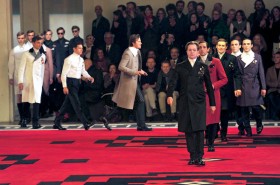 There is a moment in “Sir Vidia’s Shadow,” Paul Theroux’s memoir of a long friendship with the Nobel laureate V. S. Naipaul, when the writer describes the giddy pleasure Naipaul took in contemplating wealth.
There is a moment in “Sir Vidia’s Shadow,” Paul Theroux’s memoir of a long friendship with the Nobel laureate V. S. Naipaul, when the writer describes the giddy pleasure Naipaul took in contemplating wealth.
“Smiling beneath his sunglasses,” Mr. Theroux wrote, “he said he loved the expression ‘lots of money.’ Someone saying ‘I have lots of money’ tickled him. As we drove along he tried out the words, saying them in different ways: ‘Lots of money … Lots of money.’ ”
The passage is strange, and for many reasons, not least that Naipaul as quoted makes his point not in different ways: he repeats the same thing again and again.
Naturally enough, Naipaul’s rapture has a resonating quality at a time when jobs are disappearing and cash is scarce. And, not surprisingly, the men’s wear collections just ended here seemed infused with hunger for prosperity.
“Everyone is trying to get to the winners,” said Umberto Angeloni, the chief executive of the labels Uman and Caruso and, not coincidentally, the man who as the head of Brioni once completely transformed a faded Italian tailoring house into a hugely profitable global luxury brand. “They’re after the 1 percent.”
And this, with few exceptions, seemed to be the case.
Burberry, for instance, a label that while its bottom line has long been maintained by tartan scarves and trench coats, has kept its image refreshed by conjuring a scruffy young man of fashion with few apparent obligations and money to burn.
Suddenly, though, Christopher Bailey, the chief creative officer of Burberry, tossed out the obligatory slacker-rocker references and turned his substantial talents to that most conservative and reassuring forms of soft armor, the suit.
That he did it with confident reassurance gave reason to be hopeful. Like a sartorial version of the World War II slogan “Keep calm and carry on,” the collection sent a message of competence, quietly skillful craftsmanship and of hunkering down.
That’s not to say that the clothes on display, relatively new for the label, would qualify as interview suits (too expensive, for one thing). Yet they suggested a reason beyond mere need not to drop out altogether and to redouble one’s efforts to join the system and become gainfully employed.
Mr. Bailey’s palette telegraphed sophistication: jewel tones like amethyst and sharp spice colors like turmeric were played off one another. Shifting shapes that, like those in Rei Kawakubo’s notorious hump collection, were in fact adapted from silhouettes seen in everyday life, resulted in crisp proportional shifts.
A short puffer jacket, in other words, was layered over a tidily tailored suit. A fingertip-length coat with blanket stripes at the hem floated like a chic cloth barrel atop a pair of super-skinny stovepipe pants.
Unlike so many designers who make a fetish of “fabric research,” Mr. Bailey appeared to be under no obligation to create tricky garments. Unlike designers who seem increasingly determined to bore consumers with experiments in masculinity, he exhibited a comfortable understanding of what it means to be endowed with more testosterone than estrogen.
The same, alas, cannot be said of Miuccia Prada, whose show drew a great deal of attention for its theatricality and for the fact that she had imported a passel of Hollywood hambones seemingly to prove that being a male model is a skill.
One has only to see Garrett Hedlund jiving on a runway, or Gary Oldham or Tim Roth or Willem Dafoe doing their star struts to appreciate the efficient, businesslike silent-film beauty of the average runway worker. At any rate, the last thing this world needs on the catwalk is the Method.
And that is what the actors (possibly excepting Adrien Brody, beanpole skinny and with a sure sense of what the script requires) brought to a presentation that was graphic, theatrical and oddly anachronistic in references that called to mind the doomed Austro-Hungarian empire as evoked in the best seller “The Hare With Amber Eyes.”
It was also, as usual with Ms. Prada, fanatically detailed.
But so what?
[flagallery gid=30 name=”Gallery”]New York Times
[adrotate banner=”38″]



